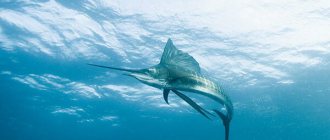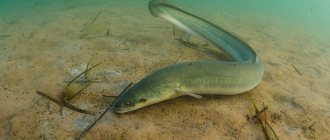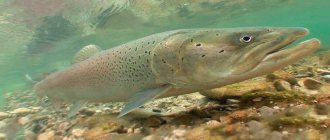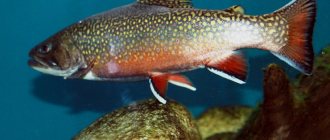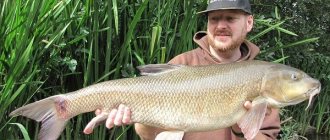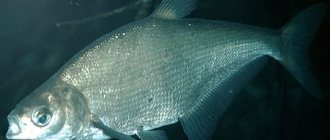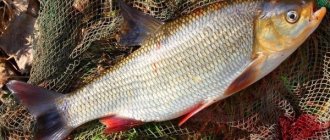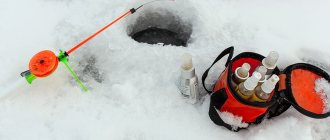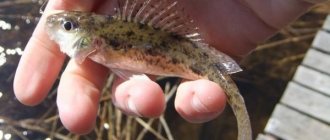Chub is a widespread medium-sized fish from the carp family. A characteristic feature of the chub is its large head, flattened on top, with a wide and flat forehead, for which it got its name. The chub is one of the popular fish among anglers who fish with fly, spinning, or float rods. There are conflicting opinions about the taste of chub meat. Some fishermen talk about the chub as a mediocre fish in terms of taste, which is interesting to catch, but not interesting to eat. Other fishermen, on the contrary, praise the chub for the taste of its meat. Let's tell you more about this fish.
Appearance
In appearance, the chub is an incredibly beautiful fish. The chub has a strong, elongated cylindrical body, slightly compressed from the sides and gradually tapering towards the tail. The shape of the chub’s body immediately shows that it is an excellent swimmer and is able to successfully withstand strong currents.
The head of the chub is much larger than the heads of most other fish found in our reservoirs. The chub's head is slightly flattened on top and has a wide and flat forehead. The chub got its name from its forehead-shaped head: chub, golovel and smut.
The chub has large, shiny, yellowish eyes. There is a brownish-yellow spot at the top of the eye.
The chub has a large semi-upper mouth, with a wide slit, the lower jaw protrudes slightly forward. The lips are thick, fleshy, strong.
The chub, like most fish of the carp family, instead of the last pair of gill arches, has bone plates, on the inside of which there are special pharyngeal teeth. Invisible from the outside, they take part in grinding food. With their help, the chub can grind even the hard chitinous shells of crayfish and beetles.
The back and sides of the chub are covered with large scales that sit firmly on the body. The scales of the chub have the color of old silver, with a slight golden tint. Each chub scale has a dark border, which widens into a spot in the front part of the scale. The lateral line is almost straight, but closer to the head it has a slight bend towards the belly; it has 44-46 scales. The chub's back is dark, almost black, with a slight tint of dark green, blue or purple. The sides are silver.
The abdomen is reliably protected from damage, like chain mail, by small, hard scales that fit tightly to each other. The abdomen is silvery with a milky tint.
The dorsal fin of the chub has 3 unbranched and 8-9 branched rays; it is colored to match the color of the back, while the outer edge of the fin is the darkest, looking like a wide dark border.
The caudal fin is notched and is colored in the same color as the back. The pectoral fins are orange, noticeably lighter below. The anal and pelvic fins are bright red, dark red or burgundy, sometimes with a colorless or darkened edge, with rounded edges.
Age and size of chub
The average size of a chub is usually 1-1.5 kg with a length of 35-40 cm. In some large rivers: the Dniester, Dnieper and some others, the chub reaches a weight of 4 kg, and sometimes 8 kg. A chub weighing 8 kg can have a length of up to 80 cm; the age of such fish is about 20 years. Cases of catching such fish are described in the literature.
The chub grows relatively slowly, at the age of 3 years it weighs only about 150 g, at the age of 6-7 years it reaches a weight of 500 grams and at the age of 9-10 years it weighs 1 kg. The growth rate of chub depends on the richness of the food supply, water temperature and light conditions.
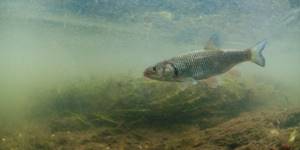
The most favorable conditions for the life of chub are found in large rivers of the southern regions; in such places chubs of maximum size are found. In reservoirs at more northern latitudes, the living conditions for the chub are not so favorable, and here they reach significantly smaller maximum sizes.
The maximum lifespan of a chub is about 20-25 years, but in nature only a few individuals reach such an advanced age.
Fishing gear
Chub is a cautious fish. She notices a fisherman on the shore and often does not react to complementary food, although she can mistake fishing boots in the water for snags. Catching this fish is one of the most exciting and sporting battles. The process of fishing for prey is also difficult: the fish desperately fights for its existence.
Spinning
Spinning fishing is best done from a boat (provided there is absolute silence). The bait is thrown under bushes hanging from the shore, cliffs and places with snags or fallen tree trunks. But if a large specimen escapes, or the fish notices the angler, the place needs to be changed. Good baits are:
- rotating spoon;
- wobblers.
Spinner spoons are effective in small to medium sizes (No. 0 to No. 3) with gold and black petals. Spinners from companies such as:
- Mepps (with black petal and orange spots);
- Myran (golden color);
- Blue Fox.
Small and medium spoons are suitable for catching fish of the appropriate size. Large spinners are not effective for large individuals: adult fish are smart and careful. To catch it, you need to use a wobbler. For spinning fishing, thick, small-sized “fat” wobblers are recommended.
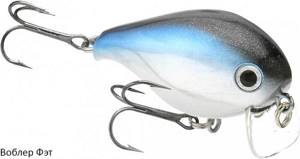
Fishermen use wobblers from the following manufacturers:
- Owner Cultiva Bug Eye;
- Smith Camion;
- Jackall Chubby;
- Zip Baits History;
- Kosadaka Roger surf;
- Straik Pro Warted Toad.
There are wobblers in the form of beetles and fry from the following companies:
- River2Sea (swimming beetle);
- Salmo Hornet - Black Tiger (black water beetle);
- Salmo Tiny (chafer bug);
- Owner Cultiva Rip'n Minnow 65 (fry);
- Yo-Zuri Crystal Minnow (fry);
- Daiwa Shiner 1062 SP (fry);
- L-Minnow 44 Sinking (fry);
- Rapala Glass Shad Rap 4 cm (fry);
- Owner Cultiva MiraShad 5 cm (fry);
- Arms Shad Micro 5 cm (fry);
- Yo-Zuri Hardcore Wo-B-Ru-1 (fry).
Float rod
These shy and wary fish can be caught if the fishing rod is equipped with discreet fluorocarbon line. This line has disadvantages: less strength and elasticity compared to braided cord and monofilament line.
Rules for choosing float gear for fishing:
- the fishing line should have a diameter of no more than 0.25 mm;
- leash - diameter 0.2 mm;
- branded fishing lines with good load are used;
- hooks - with short shank No. 7 and No. 8;
- sinker - a distance of no more than 15 cm from the hook;
- rod - at least 3.5 m (with a long reel);
- floats of soft colors (brown, black and neutral, such as “goose feather” or bulb).
The chubs bite sharply, without self-hooking, and if delayed they can break off. Feeder fishing using feeders up to 100 g is different in that self-hooking becomes possible.
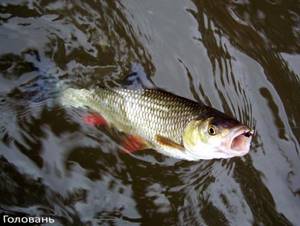
Relatives and species of chub
The chub belongs to the genus Chub, the carp family, order Cypriniformes. In the genus of chub, in addition to the common and Caucasian chub, scientists include another 52 species, all of which are found in Europe and Turkey. Most of these species occupy a very limited range. Among other well-known carp fish, the closest relatives of the chub are dace and ide.
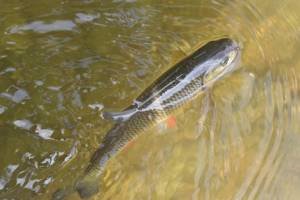
Some fishermen confuse adult chub and ide, since they are really similar to each other, have a similar color and often live in the same places. In order to distinguish these two types, you need to know the distinctive features of one from the other:
- the edge of the anal and dorsal fin in the chub is convex outward, in the ide it is concave inward
- the number of scales in the lateral line in the chub is 44-46, in the ide it is 55-60
- The chub has a large head, wide mouth, rounded sides; the ide has a moderately sized head, narrow mouth and compressed sides
- The pelvic and anal fins of the chub are red, and those of the ide are orange.
It is more difficult to distinguish a young chub from a young dace; they differ in the following characteristics:
- the size of the scales and the number of scales in the lateral line of the chub and dace are very similar, 44-46 in the chub, 46-52 in the dace
- the edge of the anal fin in dace is concave inward, in chub it is convex outward
In addition to the common chub, the Caucasian chub lives on the territory of our country. It inhabits the rivers of the Caucasus flowing into the Azov, Black and Caspian seas. It is especially numerous in the rivers Terek, Kuban, Afips, Kura, Psekups, Kuma, Zolka, Podkumok.
Nutrition
The chub is an omnivorous fish, although it is often classified as a predator. Large individuals can eat all living things that fall into the water, including mice and small birds. They are voracious and often attack small fish - bleak, roach, minnows. But predatory tendencies appear with age.
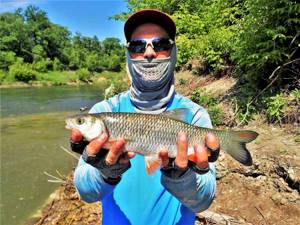
Typically it feeds on:
- fry;
- tadpoles;
- frogs;
- flying insects;
- worms, larvae, caterpillars, maggots;
- crayfish.
This fish also picks up fruits falling into the water from inclined branches of trees and bushes. Enjoys eating any berries, seeds, corn and peas. He won’t even refuse a crust of bread. Juveniles eat algae.
Attention!
The chub's favorite delicacy is beetles and crayfish. In order to grind their hard shells, it has very powerful teeth in its throat.
Spreading
The chub is widespread throughout Europe and Asia Minor. The habitat of the chub covers a large territory - from the Pyrenees to the Urals. In northeastern Europe, the chub's range reaches the Northern Dvina; in Asia Minor - to the Euphrates River. From the south, the chub's range is limited to the Mediterranean coast, from the north - to the Scandinavian Peninsula. The chub is a fairly heat-loving fish, so it does not live in regions with harsh winters, which are located east of the Ural Mountains. The eastern border of the chub's range is the rivers Ufa, Ural, Ilek, Chusovaya, Sylva and Kosva.
You may be interested in: How to choose a spinning reel
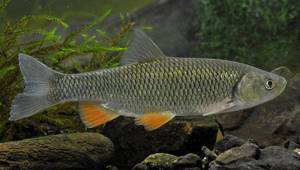
The chub is most numerous in the rivers of the Caspian, Azov and Black Seas. Found in some rivers of the Baltic and White Seas. In Europe, the chub lives in the Elbe, Rhine, Oder, Dniester, Dnieper, Danube, and Pripyat. In Russia - in the tributaries and main channels of the Volga, Kama, Western and Northern Dvina, Oka, Khoper, Vychegda, Don, Seversky Donets. In the rivers of the Caucasus, in the Kuban, Terek, Kura and others, a similar species lives - the Caucasian chub.
Behavior during spawning
Before the spawning period, chubs are not particularly active. They eat little, recovering from the cold of the winter season. They live mainly at the bottom of deep reservoirs and hunt small fish and other living creatures. This distinguishes the chub from other species in which active feeding begins during this period.
Feeling the approaching heat, and when the water reaches 10 degrees, the chubs begin migrating. They move upstream to spawning or spawning sites. This type of fish never spawns in deep-water rivers.
She looks for small warm bodies of water - tributaries, streams of large rivers. But the reservoir should not only be warm, shallow and have a lot of thickets, but the presence of a gentle current is also important. The chub does not swim in still water. Spawning times can vary greatly, ranging from a month to a week. Everything depends on weather conditions. The warmer the weather, the faster the spawning occurs.
In such conditions, the chub becomes a desirable prey for fishermen. However, it is worth remembering that fishing during spawning is strictly prohibited.
During spawning, the chub is absolutely not caught, so even if a fisherman tries to catch the fish, he will not be able to. Chubs release their eggs at one time, rather than in stages. Because of this, the eggs are very vulnerable, as they do not have time to attach to stones or plants. Most of it is carried away by the current, where it is eaten by other fish. Therefore, the chub is considered an uncommon ichthyofauna. It is impossible to catch it during spawning due to the small number and vulnerability of this fish.
After spawning is completed, the chub divides into small schools and swims into pits to recuperate. This period takes approximately a week. At this time, they eat practically nothing, and they cannot be caught. After the chub rises to its usual habitat, fishermen can go hunting with peace of mind. If a fisherman catches a small chub, he needs to release it. Young fish are quite significant for this species. She rarely survives to adulthood due to the large number of other predatory fish that do not mind eating the fry.
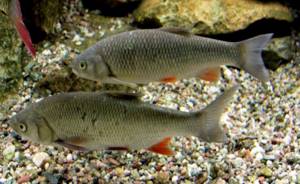
Grayling habitats
The chub is sensitive to the purity of water and its oxygen saturation, therefore it lives in rivers with high and medium flow rates. Chub are practically not found in stagnant bodies of water, preferring to leave stagnant bodies of water into the tributaries that flow into them.
In lowland rivers, chub are more often found in the upper reaches of the river than in the lower reaches and near the mouth. In mountain rivers, chubs are more often found in the middle reaches of the river and lower reaches.
Chub can sometimes be found in rivers where trout and grayling live, where other carp fish are practically not found.

Within the river, the chub selects areas with a fast current, a hard sandy or rocky bottom, steep banks or overgrown with bushes and trees. The chub avoids muddy places.
Favorite places for chub in the river:
- Riffles, where he prefers to stay in areas slightly above or below him, in relatively quiet, deeper areas, hiding behind some kind of cover
- Shallows with a sandy, rocky or simply uneven bottom
- Whirlpool, on the border of fast and reverse currents
- Mouths of fast rivers
- Sections of the river with trees and bushes hanging over the water
- Dense underwater snags
Regulation of river flow and construction of dams negatively affects the number of chub.
Places where the chub is found and lives
The chub fish has spread widely and is found throughout almost all of Europe, from Spain to eastern Russia; it is most numerous in central Russia. Its main habitat is small and fast rivers with fairly cold water. In eastern and northwestern Russia, the chub lives and sometimes lives in the same places with brook trout and grayling, where, due to low temperatures, other white fish do not appear, and char and minnow can still be found.
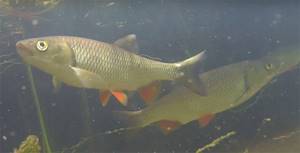
Chub fish is also found in many lakes, for example in Ilmen, Seliger and other lakes. It is almost never found in low-flow ponds and lakes, with rare exceptions. And these representatives from the carp family do not like large, navigable and slow-flowing rivers. And also if the smut is found in the river, then it is rarely found in the lower reaches, river mouths and practically never goes out into the sea.
On the river, the chub fish likes a sandy, rocky, pebble or clay bottom and avoids silt. He loves rivers with moderately fast currents, with sandbanks and rocky rifts, and also loves whirlpools under cliffs or large stones.
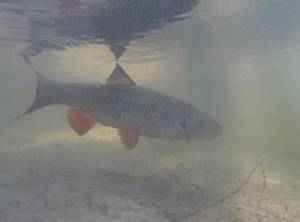
And the chub’s favorite place is to stand under the coastal bushes, which provide it with abundant food in the form of falling insects. It avoids grassy places, although it can stand next to the grass. It does not like creeks, bays and floods in the spring and avoids such places in the spring and is rarely found there, unlike ide, bream, roach, perch and pike. In general, in terms of its habitat, the chub fish is the complete opposite of the ide fish, although these are close breeds and they are very similar in appearance, but where the chub is located, there are practically no ides and vice versa.
In summer, the firebrand does not stay near the riffles all the time, it comes out there periodically, usually in the middle of the day and in clear weather, but mostly it stands on the border of the riffle with the depth, where the current is quieter and there is somewhere to hide, behind a ledge of the bottom or behind a stone. He loves to stand next to the rapids or stream that brings him food. And under overhanging bushes and trees near the shore it can be found even in still water, where it waits for insects to fall into the water from the branches.
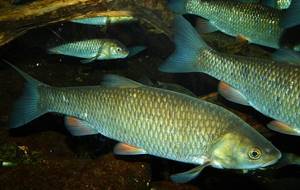
Its location also depends on the weather conditions and time of day. During the day, in clear and hot weather, they float on the surface, and in cold weather they go to the bottom. And in prolonged inclement weather they generally go into deep places and holes. At night, the chub fish also feeds, but at this time it stands in deeper places and on the bottom, and on moonlit nights it usually melts.
When there is wind in the summer, chubs come out of their places into the rapids and rise to the surface of the water in anticipation of falling insects from the branches of bushes. According to observations of fishermen, before a thunderstorm they become animated and greedily take on crayfish, which probably occurs due to the fact that crayfish come out of their holes before a thunderstorm. But as soon as thunder thunders, lightning flashes and rain begins to fall, they immediately go into the depths. And with light rain, they approach streams, where a muddy stream of water carries various food washed away from the banks.
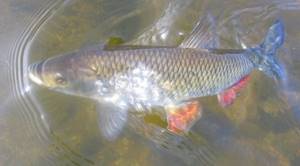
With the onset of frost and with an increase in the strength of the current in the river due to autumn rains, the chubs leave their summer places and go to deeper places. And in the fall, in October or early November, they lie down in pits for the winter and remain in a half-asleep state all winter until spring; they take food only in exceptional cases, mainly after prolonged thaws. However, it happens that in warm winters, even in December and January, they are found in shallow places of rivers or near dams and are caught well with a fishing rod.
In winter, back in February, with the first thaw, chubs begin to awaken from the winter torpor, in which they have been in deep holes in camps since late autumn, and move to shallow places and slowly, along with the flow of water, begin to rise against the current, simultaneously entering small tributaries . This spring move is made by schools of chub of approximately the same age, and quite numerous, but the number of individuals is much less than in schools of ide or roach.
Chub lifestyle
The chub is a very active and mobile fish. Young chubs usually form schools; the older they are, the fewer fish there are in the school. Large chubs live in groups of 2-3 fish, the largest chubs lead an exclusively solitary lifestyle.
In the cold season, the chub usually stays near the bottom, and in the warm season, especially during the mass emergence of insects, it often stays near the surface. Chubs often make their presence known with powerful splashes. Young chubs can jump after insects flying over the water.
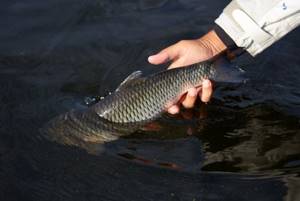
Small chubs are not particularly shy, but as the chub matures, its behavior changes. An adult chub is a very attentive and cautious fish; it notices everything that happens on the surface of the water and on the shore. If there is any suspicion of danger, the chub goes into cover or into the depths.
Young chubs are active all day, while adults are most active in the morning and evening, resting during the day. Sometimes chubs may show signs of activity at night.
The chub leads a sedentary lifestyle, making only small feeding movements up and downstream. As the water level rises, and also during spawning, chubs move upstream, entering tributaries and the upper reaches of the river.
With the onset of autumn, in September, chubs leave their summer habitats, gather in schools and stand in pools and pits for the winter. In winter, the chub does not hibernate, but remains in a sedentary, passive state and practically does not feed. However, often during winter thaws, the chub emerges from a passive state and begins to feed intensively, most often this happens in early December and late February.
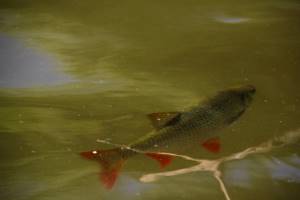
As spring approaches, the edges appear and the water level rises as a result of the flood, the chub leaves its wintering grounds. At this time, the chub tries to stay at a depth in the bottom layers, restoring strength after wintering and begins to gain body weight in preparation for spawning. As the water warms up, the chub begins to stay closer to the surface.
The chub spends the hot summer months in the upper layers, on rifts and shallows, and only the onset of autumn cold forces it to gradually go deeper.
Life cycle of a chub
When chub larvae turn into fry, they gather in schools and prefer to stay in shallow water, where there is more vegetation and small ciliates. The older the individual becomes, the smaller the group. The chub adheres to separation by age and never gathers in large schools. Adult fish always live deeper than young fish.
The largest representatives separate from the flock and stay apart, obtaining food on their own. They return to their brothers only during spawning. Under optimal living conditions, it can live 17-18 years.
What does a chub eat?
The chub can be called an omnivorous fish. The main factor determining the chub's diet is its size. The larger the chub, the more predatory habits it exhibits. Young chubs mainly feed on insects and plant matter. Adult large chubs also feed on plant foods and insects, but their diet is increasingly dominated by fish fry and other animal foods.
The basis of the grayling diet consists of various insects that either live in the water (caddisflies, stoneflies, mayflies) or accidentally fall into water (botflies, beetles, grasshoppers). The chub is very fond of May beetles, dragonflies, and grasshoppers.
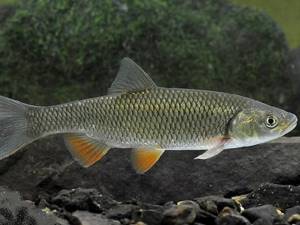
Chub of various sizes, both large and small, happily eat small crustaceans, mollusks, worms and various larvae, collecting them from the bottom of the reservoir.
For food, he can stand for a long time under the crown of a tree overhanging the water, waiting for some insects to fall from it into the water.
The wide mouth and powerful pharyngeal teeth allow the chub to cope with the hard shells of crayfish and mollusks. Large chubs are especially fond of molting crayfish, which during molting are deprived of their shell and become defenseless.
As the age of the chub increases and its size increases, food preferences change. Adult large chubs begin to hunt fry, setting up ambushes near underwater shelters. The main hunting objects of the chub are bleak and gudgeon; minnows and gobies are also its prey. The largest chubs hunt mice, shrews, voles and other small rodents that, during migration, try to swim across a small river or stream.
You may be interested in: Shimano Stella FI Reel
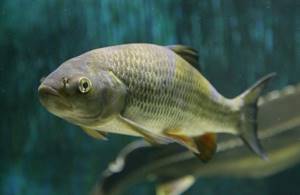
In spring, chubs enjoy feasting on the eggs of other fish and frogs. In the fall, the chub happily eats small frogs before they hide for the winter.
In the spring, chubs swim to the shore and feed on earthworms that find themselves in the river due to the onset of floods.
Chubs also feed on plant foods. Young chub eat aquatic vegetation, they especially love filamentous algae, which anglers call “water silk.”
The chub feeds on the fruits and seeds of plants growing on the banks of rivers and falling from them into the water or washed into the river by rain. The chub happily eats cherries, sweet cherries, raspberries, gooseberries, blackberries, currants, sunflower seeds, plums, young corn and peas.
Lifestyle and nutritional habits
The river chub has a pronounced seasonality of the biological cycle, which changes sharply depending on the time of year. The schooling fish spends the entire winter in pits and hardly feeds; some feeding activity is observed in early December and the last ten days of February. In early spring, maple stays at depths in the bottom layers, where it restores strength after a passive winter. As the water warms up, the fish rises closer to the surface. Spends the hot summer months in the upper layers, on rifts and shallows. Autumn cold snaps again “press” the jumper to the bottom and force them to gradually slide down to greater depths.
The chub is a universal hunter. Thanks to its high speed, it is able to quickly catch up with a fry, frog or small rodent crossing a pond. Small birds are sometimes found in the stomachs of caught turbaks.
Another feature of the jumper is its innate patience, which allows it to wait for prey in ambush for hours. During the season of insect flight and berry ripening, a chub can spend the whole day under branches hanging over the surface of the surface, waiting for a fallen insect or ripe fruit.
The demands on water quality do not extend to scrupulousness in choosing food. Despite its predatory nature, the maple eats with pleasure:
- worms, larvae, caterpillars, crustaceans;
- filamentous algae;
- bloodworms, maggots, mormysh;
- cereal grains and legumes (barley, corn, oats, peas);
- caviar of other fish and amphibians;
- dough, bread crumb and crust;
- all kinds of insects (beetles, flies, mosquitoes, dragonflies, butterflies, gadflies);
- ripe berries (cherries, cherries, raspberries, blackberries, etc.).
To learn more:
The many-faced asp: sheresper, grip and horse-fish
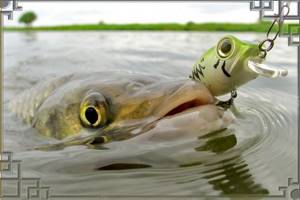
The wide mouth and powerful pharyngeal teeth allow the fish to confidently cope even with the hard shells of crayfish and mollusks. The diet of young animals is dominated by moderate dietary benthos and plant food, which affects their slow growth. Adults also dilute the menu with higher plants and algae, but are more focused on animal food, including small fish (minnow, bleak, gudgeon, goby). The main feeding period is during daylight hours. The largest chub is extremely cautious, stays solitary and feeds more often in the late evening, at night and early in the morning.
Chub breeding
The chub reaches sexual maturity at the age of 2-3 years, at which time it weighs only 100-200 grams. Chub spawning begins when the water warms up to a temperature of 12-17 degrees. This happens at different times in different regions. In the southern regions of Europe in April, in most regions of central Russia in the first half of May, in the northern regions in the second half of May - early June. Chub spawning lasts for 4-7 weeks.
The chub spawns near its permanent habitat. For spawning, it chooses shallow places with moderate currents and a hard rocky and pebble bottom. In search of spawning sites, chubs can enter tributaries of main rivers and accumulate there in significant numbers.

The chubs leave for spawning in stages; the first to spawn are large individuals, which are not spawning for the first time. Young chubs, participating in spawning for the first time in their lives, spawn a little later, when the water warms up more. At the spawning ground, the number of females is approximately twice as large as the number of males. Spawning of a flock of chubs can last up to 3 hours. The spawning of chubs is clearly visible from the shore; they stick their backs out of the water and make a lot of noise with their splashing. When one group of chubs has spawned, it leaves, and after some time another group comes to replace it. After spawning, the chubs go to deep places and there restore their strength, without feeding at all for some time. Having rested and regained their strength, after a week, the chubs begin to feed heavily, replenishing the calories lost during spawning.
Depending on its size, a female chub can lay from 10 to 200 thousand eggs. Chub caviar is small, the size of a poppy seed, and bright orange in color. Despite high fertility, the chub population does not become so numerous. A significant part of the eggs laid by the chub is carried away unfertilized by the current. The other part of the caviar is eaten by other fish, not only by predators, but also by crucian carp, bream and roach.
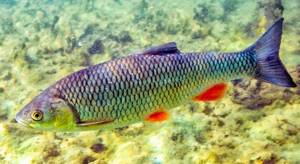
The fry develops from eggs in 5-7 days. The first time after hatching, chub fry are located near the shore, in quiet places, or hiding among aquatic vegetation.
Chub fry feed on zooplankton and, when slightly older, feed on benthos. As the fry grow older, they move closer to the middle of the river, but avoid the riffles. Closer to autumn, young chubs gather in schools, which can reach large sizes, up to several hundred or even thousands of fish, and go to the depths for the winter.
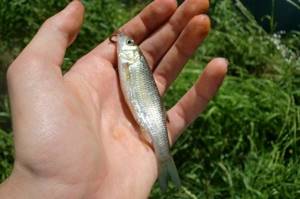
What does a chub look like?
The daredevil's unique appearance matches his tricks. The powerful chub fish has a classic structure. The streamlined, regular body is cylindrical in shape and gradually tapers towards the tail. This body shape makes him an excellent sprinter. Chub are able to easily and quickly make their way through significant movements of water. When hooked, the fish resists strongly, often emerging victorious.
A small hump on the back prevents asymmetry, thanks to the wide, flattened forehead on the thick head. The prominent part of the body served as the leitmotif for the name of the species and the nickname smut.
A representative of the Cypriniformes order, it is endowed with a truly regal coloration. The back is dull green, and sometimes almost black. The smut has truly gigantic scales, which smoothly transition into a smaller structure of silvery sides. Their number is not large and ranges up to 50 pieces, tightly settled on an elastic body. The almost white belly of the chub is protected by a frame of tiny scales.
The yellowish pectoral fins have an orange sheen. A pair of ventral feathers and anal feathers are painted in a bright reddish color. Framed with a dark or colorless edging, they turn the chub not into a river inhabitant, but into an inhabitant of exotic seas. The fins of the back and tail of the usual grayish-brown color destroy this impression. They look like the logical completion of the back. Depending on the habitat, age and time of year, the color nuances of the chub can vary from more saturated to almost white solutions.
Recommended reading: How to catch a loach
Large amber eyes, fleshy lips, and a large slanted mouth complete the portrait of an extraordinary fish. Particularly noteworthy are the massive jaws, which are capable of firmly holding prey, crippling gear. Pharyngeal teeth act as a formidable weapon against the houses of crustaceans and the dense chitinous shells of beetles. For such tricks, the chub is not popular among its aquatic neighbors, but it is gaining momentum as a fishing trophy.
Enemies of chub in nature
Until the chub reaches the size of an adult fish, it is hunted by many aquatic and terrestrial predators. In the water, young grayling are hunted by predatory fish: pike, pike perch, perch and asp. Many species of fishing birds, such as herons, kingfishers, terns and gulls, enjoy preying on young chub.

Among land animals, the chub is preyed upon by large waterfowl mammals such as minks and otters. Taking into account the colossal percentage of death of fry, only a few individuals of chub survive to adulthood. An adult chub, having reached 2-3 years of age, feels quite at ease in the river; by and large, it has no natural enemies left in the river, with the exception of very large pike. True, a large chub can be forced out of its area by large ide or asp. But still, the main danger for large chubs is the person who catches this fish in a variety of accessible ways.
Seasonal baits and baits for chub
At certain times of the year, different natural baits work. In the spring, with the opening of the chub season, the fish becomes a fanatical fan of the cockchafer; if other insects interest it, it is with less temperament. Not as fun as a beetle, but they also work well in the spring: small dung worms, maggots, bloodworms, caddis flies, flies, tadpoles and grasshoppers.
In the summer, when live bait is of little interest to the chub, the grasshopper and also the whitebait are especially helpful. At this time, the big-headed fish takes well young corn, pearl barley, bread, processed cheese, beef liver and heart. As soon as the cherry is ripe, you can try fishing with it after slightly drying the fruit. Chub bite on gooseberries, raspberries and black currants is a little worse, but large specimens are usually caught on berries. In general, it should be noted that the chub is a very voracious fish. At the beginning of September, with the onset of cold weather, our hero becomes surprisingly picky and eats everything in sight on the eve of winter.
You can see how he grabs bread crusts, pieces of cheese and even radishes floating with the flow - gifts received from careless tourists who did not bother to clean up the leftover food.
Animals, of course, love the “Danaans who bring gifts” and want them to leave as much food for them as possible, but without bags and plastic utensils, which require special disposal.
I apologize for the slight digression. All the best, happy fishing.
Chub fishing
The chub is of great interest for sport and recreational fishing, the reason for this is not its taste, but the interesting process of catching it. Chub fishing is not carried out on an industrial scale.
The chub is a very careful and strong fish; it is an honor for any angler to catch it. Chub fishing is very exciting and interesting, requiring high skill from the angler. The chub spends most of its life in a strong current, in constant struggle with which it becomes incredibly strong and resilient. A small chub caught on a hook, weighing only 200-300 grams, stubbornly resists and behaves like a fish of much larger weight. Catching a trophy chub is a real victory for an angler.
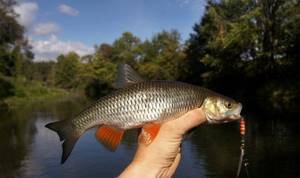
Chub are caught in a variety of ways. In the summer, chub are caught by fly fishing, drag fishing, float and bottom fishing rods, and spinning rods.
Chub is the main fish caught by fly fishermen in the central zone of our country. Fly fishing for chub is one of the most interesting and exciting ways to catch this fish. When fly fishing, special artificial flies that imitate insects are used as bait. The fly must imitate the insect as accurately as possible, otherwise such an attentive and cautious fish will suspect deception.
Chub can be successfully caught using a float rod. In the spring, good baits for catching chub include: chafer, small dung worm, maggot, bloodworm, caddis, fly, tadpole and grasshopper. In summer, the chub readily eats: grasshopper, fry, young corn, pearl barley, bread, processed cheese, beef liver and heart. In autumn, the chub is extremely picky about food and takes any bait offered to it by the fisherman. The chub takes it especially greedily in the spring, in mid-May and with the onset of autumn. Since chub fishing is carried out in the current, the float should be small, light, sensitive, with a long keel, and not brightly colored. The fishing line is used with a thickness of no more than 0.15-0.20 mm.
You may be interested in: Spoons for pike
Catching chub with a fishing rod and line can be successful. The fisherman lets the bait float freely and watches the float, helping the fishing line clear from the spool. Fishing is carried out in pools with whirlpools and holes, with a weak current on the river. The following can be used as bait: grasshopper, cockchafer and its larva, dough, worms, fingerlings, bread crust or crumb, crayfish or shellfish meat, corn. When fishing by wire, you can fish in the current, throwing bait into the stream and floating the bait 15-20 meters downstream, if bushes or other anglers do not interfere with this. For line fishing, a regular Bolognese telescopic rod 4-5 meters long is suitable; if the banks of the river where fishing is carried out are heavily overgrown with bushes, you can take a rod 2.5-2.7 m long. For fishing, use a thin monofilament line with a diameter of 0, less noticeable in the water. 20 mm, for the leash use a leash monofilament 0.14 - 0.16 mm, no less than 60 cm long.

In early spring and late autumn, in cold water, fishing with a bottom fishing rod gives good results. Donka allows you to fish holes, deep slopes, coastal and channel edges. For fishing with a bottom fishing rod, the same attachments are used as for fishing with float gear. Fishing with live bait gives good results.
When catching chub with a spinning rod, anglers use a variety of baits: wobblers, small spinners, micro-oscillators. Light class spinning rods with an upper test limit of no more than 12 grams are used. The fishing line used is monofilament, with a breaking load of about 2 kg, or a braided cord with a fluorocarbon leader. As wobblers for catching chub, I use cranks 3-3.5 cm long. Fishing for grayling with a spinning rod is most often carried out on riffles and other places in the river with a fast current. Chub can be caught both from the shore and by wading.
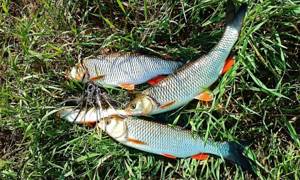
Chub are also caught using mini spinners weighing 3.5-6 grams and rotating spoons. Spoons when fishing for grayling are most often numbered No. 0, No. 1 and No. 2. Chub are best caught with spoons in July, when they are at their peak of activity. The chub does not like to chase a fast-swimming spinner or wobbler. Rewinding the line should be done at a slow pace. The chub bite is so sharp that it can knock the rod out of the angler’s hands. A hooked chub strongly resists at the beginning of fishing, makes strong jerks, can make a candle or try to go into snags, but quickly gets tired and allows itself to be brought to the shore.
Chub lifestyle and nutrition
This representative is a semi-predatory species of the underwater world. It feeds on vegetation, insects and small fish. Even fully formed and adult individuals remain semi-predatory and regularly eat vegetation.
The chub eats with pleasure:
- worms;
- various insects;
- shellfish;
- little fish.
With the onset of cold weather, it changes its habitat, giving preference to shallower places, where its main food becomes small fish and frogs.
For the predominant part of their existence, chubs adhere to a school lifestyle. Having reached large sizes, they prefer to leave their schools.
Interesting fact: Chub is a very aggressive fish. It bites so sharply that it can easily knock the rod out of the hands of an unsuspecting fisherman. A hooked chub exhibits extremely strong resistance - in order not to go into the frying pan, the predator makes “candles” and other “feints” in order to go into the saving snags, where it costs nothing to tangle the fishing line. According to experienced fishermen, the chub demonstrates its greatest strength during the first jerks. If you overcome them, then it will not be difficult to fish the fish ashore. Don’t be afraid to hook - the chub’s mouth is strong and will withstand it. But if you hook it poorly, the fish will most likely get off the hook.
The period of the highest activity of this representative is early morning, when they go in search of food. Sometimes they can hunt at night, because late in the evening they feel the greatest hunger. Anglers should take note of this fact if they want to catch a large representative of chub.
Chub in cooking
Fish meat has high nutritional value: 125-130 kcal per 100 grams of product. Chub meat is considered a dietary product, as it contains a large amount of protein (17.8%) and has a low fat content (5.6%). It has a balanced vitamin and mineral composition, contains a large amount of phosphorus, potassium, sodium and calcium, and is rich in vitamins A, B1, B5, B6, B9, B12. Dishes prepared from chub meat are easily digestible and do not slow down the metabolic process.
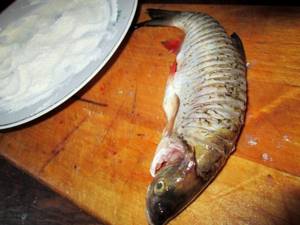
Fishermen have two directly opposing opinions about the taste of chub meat. Some fishermen talk about the chub as a mediocre fish in terms of taste, which is interesting to catch, but not interesting to eat. Other fishermen, on the contrary, praise the chub for the taste of its meat.
The chub is a rather bony fish, the meat of which slightly gives off a specific smell of river mud; some people are indifferent to this smell, or even like it, while others find it very unpleasant. The small thymus bones of the chub can create inconvenience when a person eats this fish.
This is especially true for boiled, stewed or hot-smoked chub. Chub marinated with vinegar, well-dried or fried, with preliminary cutting of the carcass, does not have this drawback.
You can get rid of small bones by turning the chub meat into minced meat, and it is advisable to turn it several times. You can also solve the problem of small bones by preparing canned fish from chub.
You can get rid of the unpleasant smell of mud characteristic of chub by marinating or soaking its meat in salted milk. You can marinate the chub either in vinegar or lemon juice with spices. Properly cooked chub has good taste.
You can prepare many unusual, original and tasty dishes from chub. Chub can be boiled, fried, stewed, salted and baked.
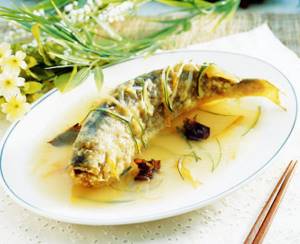
Chub makes a delicious fish soup, especially if it is prepared right on the shore, from freshly caught fish. A tasty dish is obtained by frying chub, as well as by baking it on the grill. You can bake chub with vegetables in foil. Chub can be salted and dried. Minced chub is used to make cutlets, meatballs, and pie filling.
Fishermen can cook chub immediately after catching it using a simple and tasty recipe. Clean the caught chub, sprinkle with salt and ground pepper, wrap in three layers of aluminum foil and bake in the hot ash of a fire for 35-40 minutes. Chub cooked over a fire, fragrantly smelling of smoke, will pleasantly surprise you with its taste and aroma.

